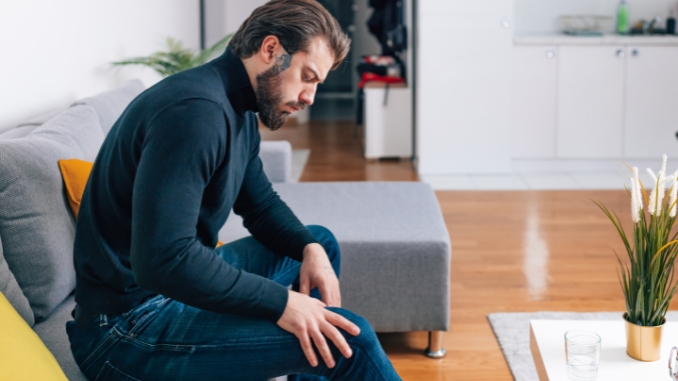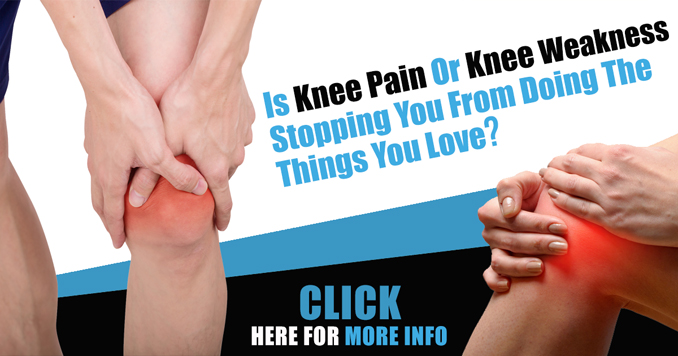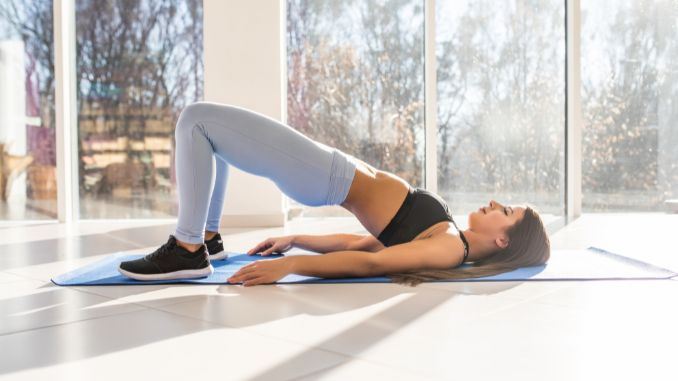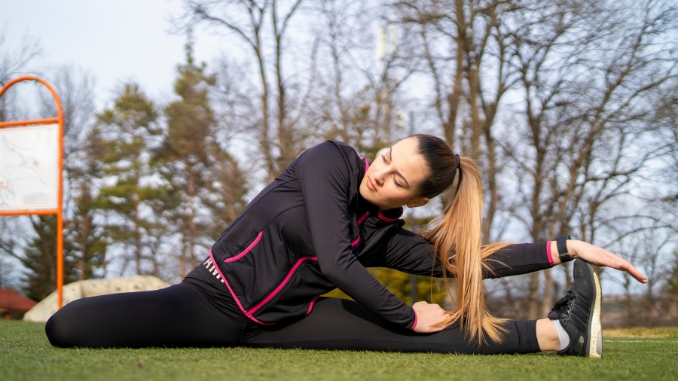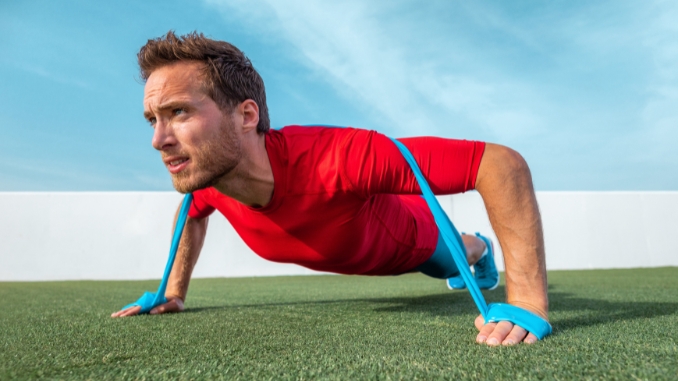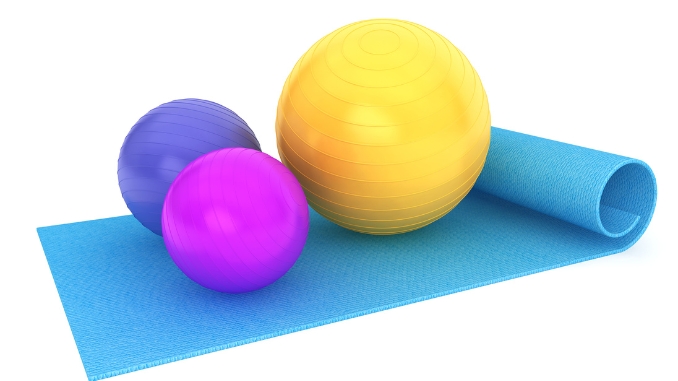Disclaimer: Please remember that the content provided about stiff knees after sitting is intended for informational purposes only. It is not intended as a substitute or to serve as medical guidance. Before initiating any new exercise routine, consulting with a healthcare professional is highly recommended.
Understanding The Stiff Knees Issue
Sitting for long periods of time can make your knees stiff. To understand why, knowing the knee joint's anatomy and the negative effects of limited movement is important.
Static positions, like prolonged sitting, can significantly tighten muscles especially those around your knees, resulting in restriction of joint movement, and contributing to knee joint stiffness.
Additionally, this can reduce blood flow[¹] to your knees, further exacerbating the issue, and potentially leading to more long-term problems like knee osteoarthritis.
The good news is that there are simple ways to prevent stiff knees after sitting. This includes regular movement, ergonomic practices, maintaining a healthy weight, and staying hydrated.
Targeted exercises, focusing on muscle strength and joint flexibility, are your best defense against future problems. This approach not only improves overall knee health but also reduces the risk of developing conditions like knee osteoarthritis, runner’s knee or stiff knee syndrome.
Anatomy of The Knee
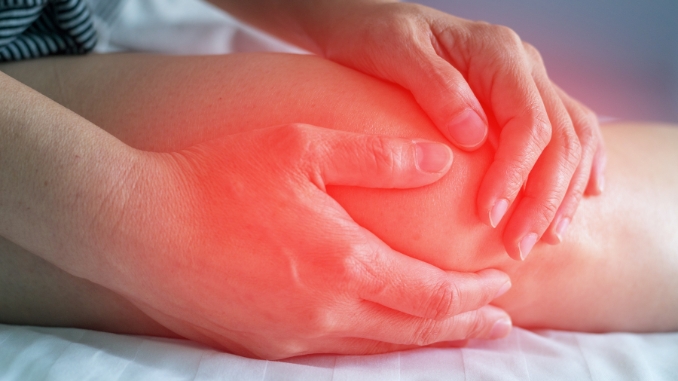
The knee joint, a complex structure of bones, ligaments, tendons, and cartilage, relies on synovial fluid for lubrication. This ensures smooth, and pain-free joint movement.
Prolonged sitting, however, limits movement, and hinders the circulation of synovial fluid. This in turn diminishes its lubricating abilities. Reduced lubrication due to limited movement during prolonged sitting increases friction within the knee joint, leading to discomfort and pain.
Research shows a link between limited movement and knee pain caused by various factors. Since prolonged sitting[²] can cause the muscles around the knee to become tight, limiting flexibility, it emphasizes the importance of incorporating activities that promote joint mobility to prevent knee-related issues associated with prolonged sedentary behavior.
Sitting for extended periods also impedes blood flow to the knees, affecting nutrient delivery and waste removal. While prolonged sitting is detrimental to knee health, excessive movement can also be counterproductive. Peer-reviewed research highlights the importance of finding a balance.
Conversely, excessive force or repetitive high-impact movements can strain the knee and contribute to problems like swelling, ligament injuries, meniscus tears, and even worsen existing conditions like arthritis, osteoarthritis, and rheumatoid arthritis.
Tips for Preventing Stiff Knees

1. Regular Movement
Regularly engaging in active movement from time to time is the key to keeping your knees healthy and mobile. Movement prevents the muscles and tissues around the knee joint from stiffening which can limit flexibility and increase your risk of injury.
In addition, movement also stimulates the production of synovial fluid, a lubricant crucial for smooth joint function. This reduces friction in the joint and helps prevent pain and discomfort.
2. Maintain a Healthy Weight
Excess weight puts extra stress on your knee joints, accelerating wear and tear. Maintaining a healthy weight is crucial for protecting your knees[³] from injury and stiffness.
3. Stretching and Strengthening Exercises
Exercising regularly can also help prevent stiff knees after sitting, especially activities that target the muscles around the knees, can significantly improve overall knee health.
Exercises such as Calf Raises, Leg Circles, Step-Ups, Knee Lifts, and Knee Extensions can all help promote health and movement within the knees and prevent stiffness from occurring.
Exercises to Relieve Stiff Knees
1. Knee Lifts
Begin in an upright standing position with your feet hip-width apart, maintaining good alignment with your head, shoulders, hips, and legs. Place your hands on your hips. Engage your core. Lift your one knee up, ideally at hip height. Hold the position for a couple of seconds, then lower your knee down to return to the starting position. Repeat the movement for the other leg. Complete the movement for 10 repetitions on each leg.
To make the exercise easier, utilize the back of the chair for support.
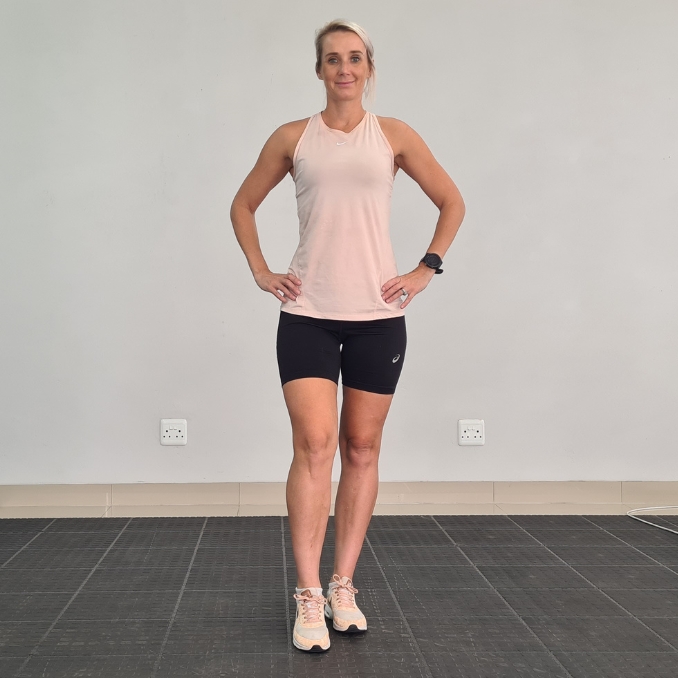

2. Quad Stretch
Begin in an upright standing position with your feet hip-width apart, maintaining a good alignment with your head, shoulders, hips, and legs. Engage your core, bring your heel up against your seat, and hold onto your foot with your hand for support. Hold the position for a couple of seconds. Relax and repeat the movement on the opposite side. Complete the movement for 5 repetitions for each leg.
To make the exercise easier, utilize the back of the chair for support.
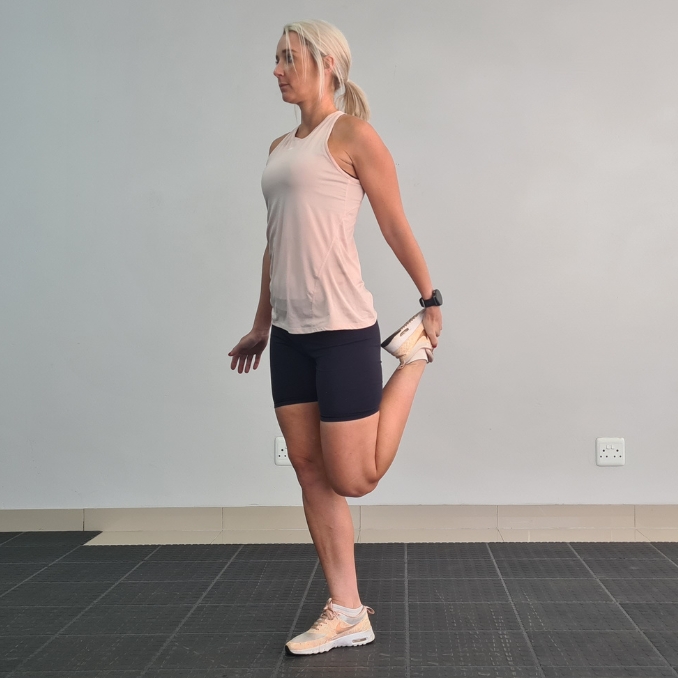
3. Calf Raises
For this exercise, utilize a chair, wall, or something similarly sturdy for support if necessary.
Begin in an upright standing position with your feet hip-width apart, maintaining good alignment with your head, shoulders, hips, and legs. Hold the back of the chair with both hands for support and engage your core, then tuck your toes to lift your heels up. Hold the position for a couple of seconds and slowly lower your heels to return to the starting position. Complete the movement for 2 sets with 5 repetitions.
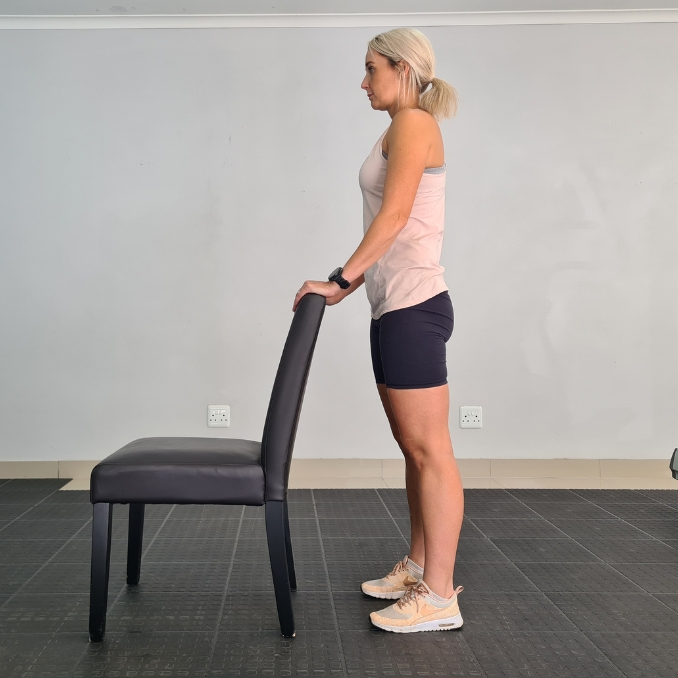
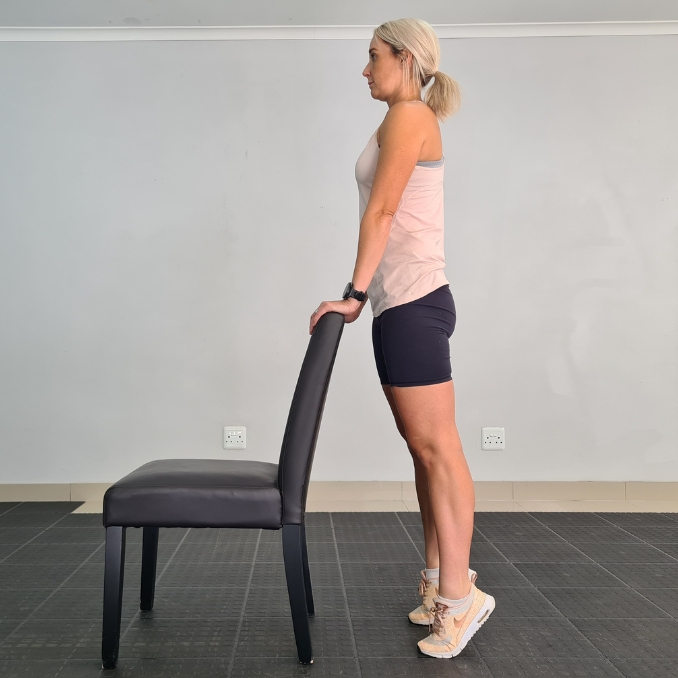
4. Seated Knee Extension
For this exercise, utilize a chair for support.
Begin in an upright sitting position on a chair with your feet hip-width apart, maintaining good alignment with your head, shoulders, and hips. Engage your core. Lift one leg, ideally at hip height, with your toes pointing towards the ceiling. Hold the position for a couple of seconds, then slowly lower your leg to return to the starting position. Repeat the movement on the other foot. Complete the movement for 4 sets with 5 repetitions for each leg.
The exercise can also be performed on the floor or ground by bending one knee with your foot flat on the floor and placing a rolled towel or blanket under your opposite knee for support.
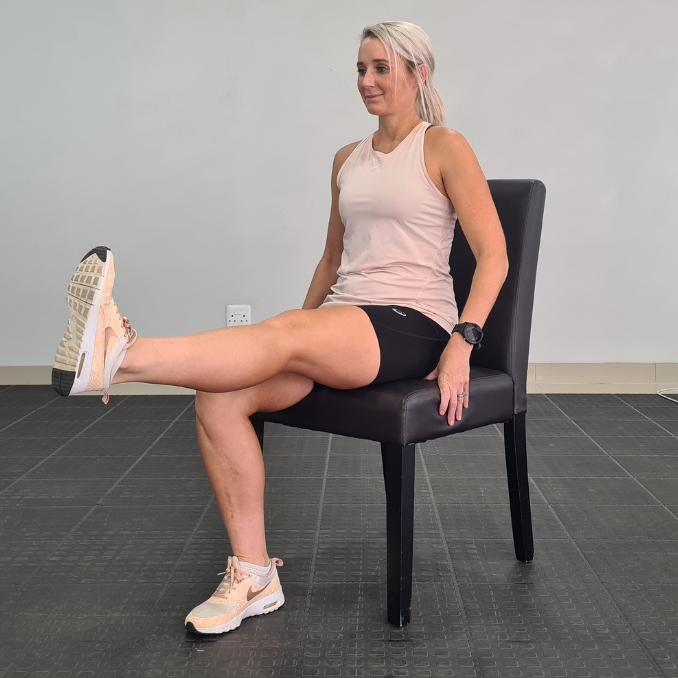
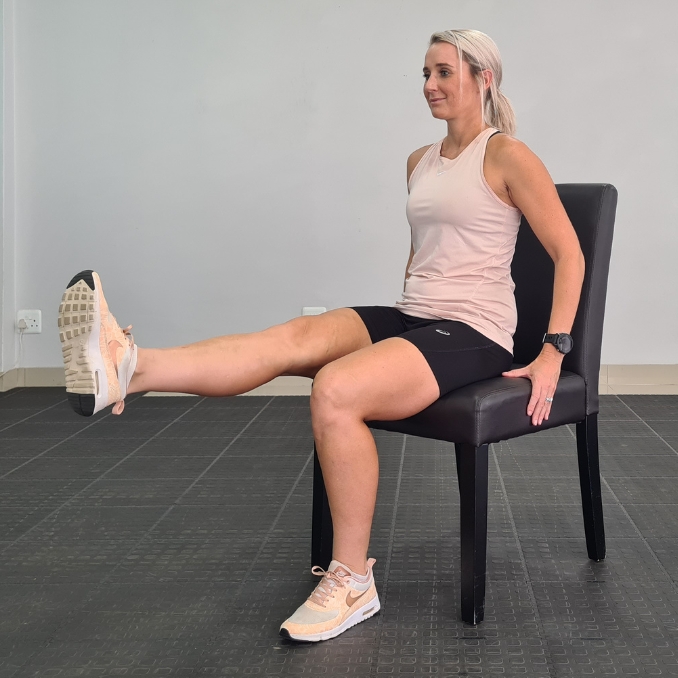
5. Step Ups
For this exercise, utilize a platform, step, bench, or stairs for support. The height should allow your knee to form a 90-degree angle when positioned on the platform.
Begin in an upright standing position with your feet hip-width apart, near a platform, maintaining a good alignment with your head, shoulders, hips, and legs. Place your lead foot on the platform, keeping your body straight. Engage your core. Push through your lead foot, driving your weight upward until your leg is straight. As you rise, either bring your other foot up to meet the lead one on the platform or drive it into a high knee position without resting it on the platform. Lower your non-lead leg back to the starting position in a controlled manner. Complete your desired number of repetitions on one side before switching to the other leg.
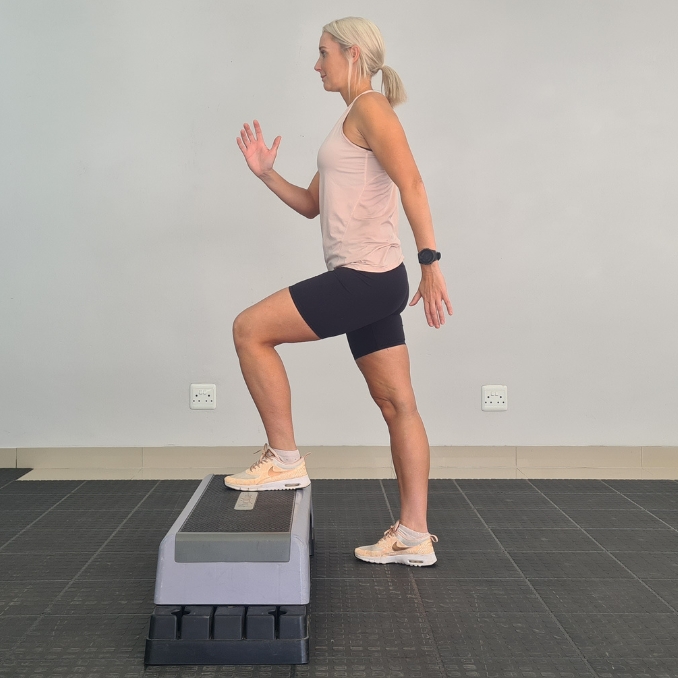
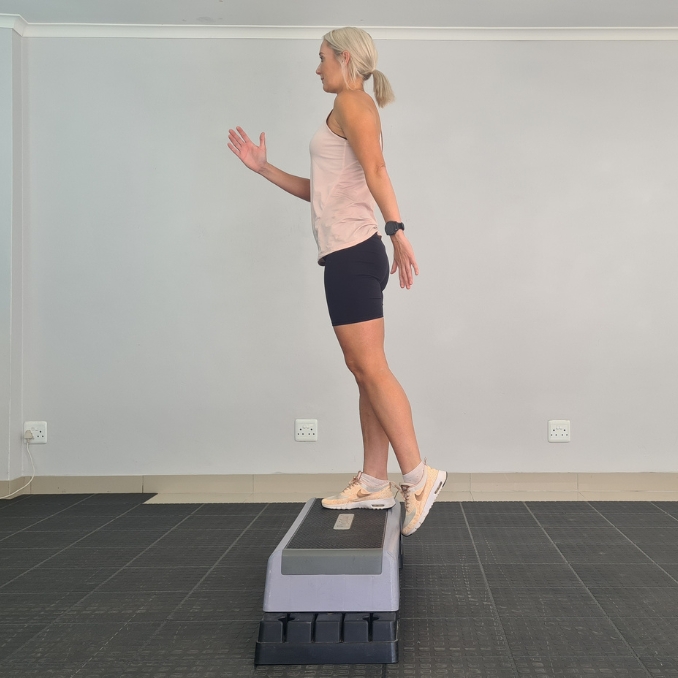
Lifestyle Recommendation for Proper Knee Health
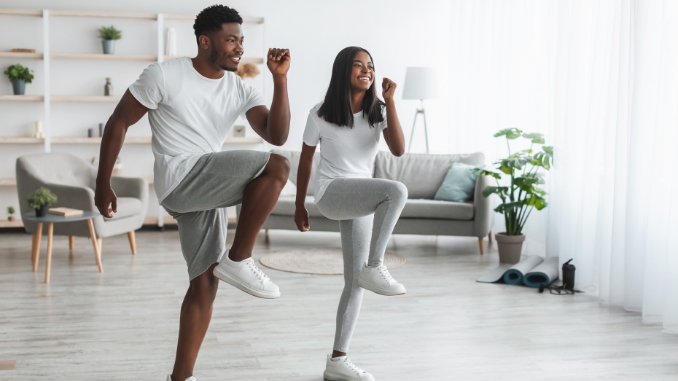
1. Maintaining Optimal Knee Health
Maintaining optimal knee health[⁴] is essential for overall well-being and mobility. To achieve this, consider incorporating key practices into your daily routine to promote healthy knees. Engage in activities that target the muscles around your knees. Walking, cycling, and swimming are excellent options as they promote flexibility and support healthy joint function.
2. Diversify Your Exercise
Include a mix of cardiovascular activities like walking, swimming, or cycling to improve overall fitness.
Furthermore, it can also help reduce weight since excess pounds can exert additional stress on your knees. Strength training exercises that target the muscles around your knees are also crucial. This balanced approach helps maintain flexibility and strength, reducing stress on your joints.
3. Correct Diet
Adapting a balanced and nutrient-rich diet and proper hydration helps keep your joints lubricated and functioning smoothly. Sitting for long periods can lead to stiff knees. Be mindful of your posture, especially when seated, to keep your joints healthy.
4. Rest and Recovery
Listen to your body, avoid overexertion, and keep within your knee's comfortable range of motion. Take rest days to allow your knees to recover and prevent pain.
If you experience persistent discomfort or have pre-existing medical conditions, talk to your doctor for personalized guidance. By following these recommendations, you can take charge of your knee health and move towards a pain-free lifestyle.
Conclusion
Addressing stiff knee joints involves understanding their structure and the effects of prolonged sitting. Remember that taking proactive steps to maintain flexibility and strength is key. Regular movement, maintaining a healthy weight, and targeted exercises are great solutions for preventing knee stiffness and related problems.
Following these steps can improve knee health, reduce discomfort, and enhance overall mobility. Consult a healthcare professional to customize a new exercise or therapy suitable to your individual needs; a personalized approach is key for effective treatment.
Is knee pain or knee weakness stopping you from doing the things you love or the basic daily tasks and movements you need to do? Check out this 10 Easy Movements for Stronger Knees now!

